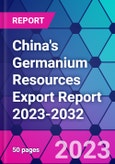In a significant development, on July 3, 2023, China's Ministry of Commerce and the General Administration of Customs issued a proclamation. This proclamation, approved by the State Council of the People's Republic of China, establishes export controls on gallium and germanium-related items, aiming to safeguard national security and interests. These controls will be enforced starting from August 1, 2023, with administrative penalties or potential criminal liability for unauthorized exports or violations of the authorization scope.
Examining the export trends from 2018 to 2022, China's germanium resources exports displayed an overall upward trajectory. However, in 2022, export volumes dipped by 12.1% year-on-year, totaling around 19,315 tons, while the export value rose by 18%, reaching approximately 223 million U.S. dollars. During the same period, the average price of China's germanium resources exports witnessed fluctuations but generally trended upwards, increasing from USD 9.3 per kilogram in the first half of 2018-2023 to USD 12.1 per kilogram.
China's germanium resources found their way to approximately 30 countries and regions across the globe in 2022-2023. Leading destinations for these exports, in terms of value, include Japan, Germany, France, South Korea, and the United States. Japan emerged as the primary recipient, receiving around 30.9% of China's total germanium resource exports in 2022, amounting to about 5,960 tons and a value of approximately US$51.4 million, making up 23.0% of the total export value for that year.
China's prominence in the global germanium resources market is undeniable. Nevertheless, with the implementation of export restrictions effective from August 1, 2023, a notable decline in export volume and value is anticipated in 2023 compared to the previous year. This development raises questions about the future of China's germanium resource exports, which will be explored in more detail in upcoming sections. These sections will delve into key drivers, challenges, opportunities, and competitive dynamics, as well as the impact of COVID-19 and constraints on the growth of this industry.
Topics covered:
- Export Status and Main Sources of Chinese Germanium Resources, 2018-2022
- Key Drivers and Market Opportunities for China's Germanium Resources Exports
- What are the key drivers, challenges and opportunities for China's germanium resources exports during the forecast period 2023-2032?
- Which are the key players in the Chinese germanium resources export market and what are their competitive benchmarks?
- What are the expected revenues from the Chinese germanium resources export market during the forecast period of 2023-2032?
- What strategies have been adopted by the key players in the market to increase their market share in the industry?
- Which segment of the Chinese germanium resources export market is expected to dominate the market by 2032?
- What are the competitive advantages of the key players in the Chinese germanium resources export market?
- What is the impact of COVID-19 on China's germanium resource exports?
- What are the main constraints inhibiting the growth of China's germanium resource exports?
Table of Contents
Methodology
Background research defines the range of products and industries, which proposes the key points of the research. Proper classification will help clients understand the industry and products in the report.
Secondhand material research is a necessary way to push the project into fast progress. The analyst always chooses the data source carefully. Most secondhand data they quote is sourced from an authority in a specific industry or public data source from governments, industrial associations, etc. For some new or niche fields, they also "double-check" data sources and logics before they show them to clients.
Primary research is the key to solve questions, which largely influence the research outputs. The analyst may use methods like mathematics, logical reasoning, scenario thinking, to confirm key data and make the data credible.
The data model is an important analysis method. Calculating through data models with different factors weights can guarantee the outputs objective.
The analyst optimizes the following methods and steps in executing research projects and also forms many special information gathering and processing methods.
1. Analyze the life cycle of the industry to understand the development phase and space.
2. Grasp the key indexes evaluating the market to position clients in the market and formulate development plans
3. Economic, political, social and cultural factors
4. Competitors like a mirror that reflects the overall market and also market differences.
5. Inside and outside the industry, upstream and downstream of the industry chain, show inner competitions
6. Proper estimation of the future is good guidance for strategic planning.

LOADING...








